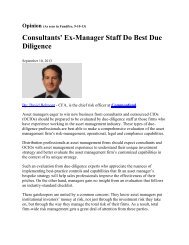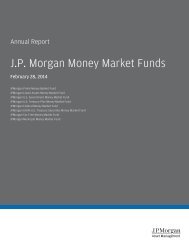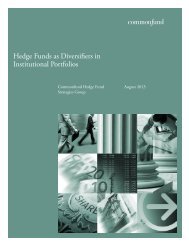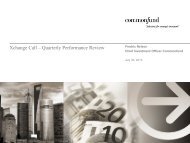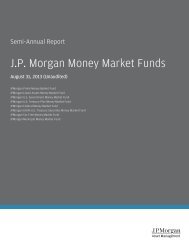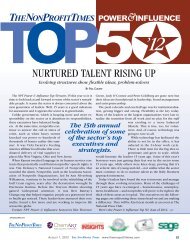The Investment Policy Statement - Commonfund
The Investment Policy Statement - Commonfund
The Investment Policy Statement - Commonfund
Create successful ePaper yourself
Turn your PDF publications into a flip-book with our unique Google optimized e-Paper software.
Conclusion.<br />
In the past, many investment policy statements gave relatively cursory treatment to<br />
risk, its quantification and its potential impact on the asset pool. <strong>The</strong> market collapse<br />
and credit crisis of 2007-2009 demonstrated that many institutions’ portfolios carried<br />
unacknowledged risks, that their risk profiles in general were higher than they thought,<br />
and that the risk tolerance of their fiduciaries was lower than acknowledged. Today,<br />
then, it is entirely appropriate to put risk at the top of the process of investment policy<br />
development.<br />
Financial models, as the crisis demonstrated, are anything but infallible and, when<br />
consulted, must be used with care and a healthy degree of skepticism. It is nonetheless<br />
true that the results of an appropriate simulation or modeling study can assist<br />
fiduciaries in going beyond traditional risk definitions such as volatility to examine<br />
such critical parameters as the risk of permanent loss, year-to-year declines in spending,<br />
and recovery periods. <strong>The</strong>se metrics both enable and force a discussion about tolerable<br />
levels of risk, the conclusions from which can be used to guide the construction of<br />
a range of potential portfolios that embody those risks that are deemed acceptable.<br />
Projected returns from these portfolios are an outcome which, if considered<br />
insufficient, indicate either acceptance of lower contributions for the acceptable<br />
level of risk or mandate a more robust discussion about the relationship between risk<br />
assumption and needed long-term returns.<br />
Thus, in this proposed structure, instead of starting with return, committees work<br />
toward it. If, ultimately, the projected range of returns is seen as ‘too low’ compared<br />
to anticipated institutional needs, then the fiduciaries must either reconcile themselves<br />
to the fact that the target return is beyond their reach given their risk limits, or accept<br />
the necessity of embracing additional risks and explicitly acknowledge them in the<br />
investment policy statement.<br />
©2011 COMMONFUND 13



